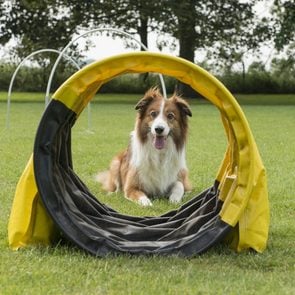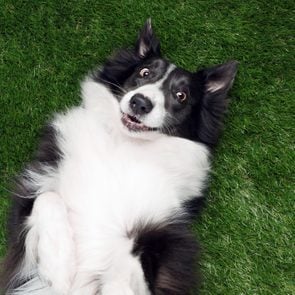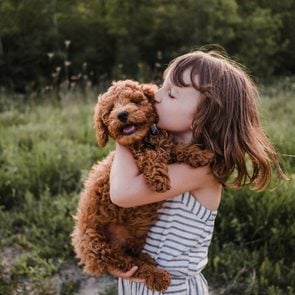Why Do Dogs Hump—and How Can You Stop It?
Updated: Nov. 07, 2023
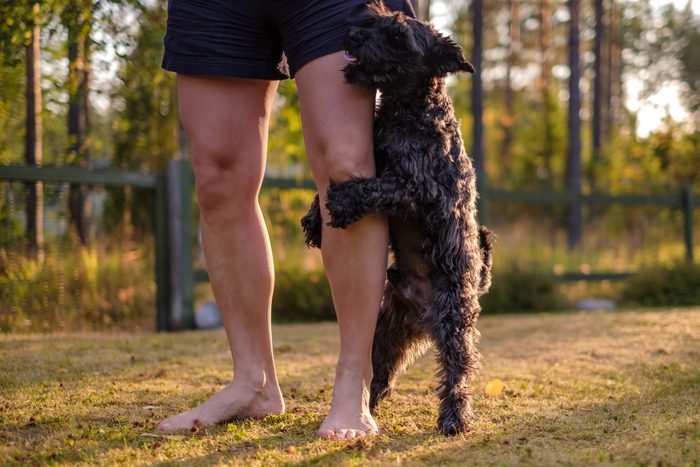
Whether you've caught your dog humping a pillow, another pup or your friend's leg, it can be an embarrassing but perfectly natural canine behavior. Here's why dogs hump and what to do next time it happens.
Some dog behaviors are downright adorable, like when they stare at us with their sweet puppy dog eyes or disarm us with that dashing doggy smile. But then there are those habits that are downright gross, like when dogs sniff other dogs’ butts or when dogs eat poop. They have cringeworthy habits too, like when dogs sniff your crotch. But there is one behavior that makes us want to crawl into a hole, and that’s humping. For the love of Milk-Bone, why do dogs hump?
If they’re not humping another dog, it’s your friend’s leg or your favorite pillow. But is it normal? We talked to veterinarians and canine behavior experts to get the answers to this awkward doggy-style dilemma—and how to get them to stop.
Get Reader’s Digest’s Read Up newsletter for pets, humor, cleaning, travel, tech and fun facts all week long.
Why do dogs hump?
Dogs are social animals that communicate in a variety of ways. Some include subtle facial expressions, such as yawning (which could mean they are tired or stressed) or lip licking (which could convey they are anxious or dehydrated). Other communication methods are blatantly obvious, like humping.
Humping (also known as mounting) is completely natural, but it’s not a canine behavior you can easily ignore. “It’s important to note that all behaviors in dogs have a function and reason why they are taking place,” says Darris Cooper, a certified dog behavior specialist at Petco. “There can be many reasons that both male and female dogs engage in humping, and it’s not always for reproduction.” Here are some common explanations.
Displacement behavior
Displacement behavior is swapping out one behavior for another. It can occur when your dog is frustrated, tired, anxious or afraid. “Humping can be a displacement behavior, meaning they engage in it when suppressing another behavior, such as jumping on guests when they walk into the home,” Cooper says. In other situations, displacement behavior is a welcome thing. For example, when a child is hugging and kissing a dog’s face, the dog may start to yawn and lick the child (or themselves) instead of getting up and walking away or biting or nipping them.
Attention-seeking behavior
Dogs sure know how to push our buttons to get our attention. They might bark, whine, beg or steal something and run off. They might gently paw when you stop petting them or bring you their toys to play with. It generally doesn’t matter if the resulting attention is positive (“Good girl!”) or negative (“Bad girl! Give me back my slipper!”), it’s rewarding to the dog, so they keep doing it. The same is true with humping.
“As humping typically gets a reaction from pet parents, the attention may be rewarding enough for a dog to continue the behavior,” Cooper says.
Anxiety or stress
“Some dogs may use humping as a default behavior or coping mechanism if they don’t know how to calm themselves and self-settle in certain situations,” Cooper says. For example, if a new dog or person comes to your house, your dog might hump them or nearby inanimate objects like pillows or stuffed animals to soothe their stress or anxiety. Either way, humping is one way your dog is asking for help. “We humans have yoga, meditation and therapy, but dogs? They’ve got humping,” says Matthew McCarthy, DVM, a veterinarian and the founder of Juniper Valley Animal Hospital in Queens, New York.
Excitement
Why do dogs hump when they are excited? Humping is sometimes a sign of energy arousal. A dog may get pumped up to see other dogs at the dog park, sending dog park etiquette out the window. Or they might be reveling in the excitement of playing a rousing game of fetch, and when you stop, they may redirect their efforts by humping a nearby pillow (or your leg) to relieve themselves of pent-up energy.
Arousal
It’s hard to fathom your sweet and lovable dog as part of the birds-and-bees equation. Puppies just appear in a cute basket with a bow on top, right? Aside from humping to make more puppies, dogs of both sexes might hump just because it feels good. Humping behavior can occur in both male and female dogs, regardless of whether they have been spayed or neutered. In some cases, it may be a sexual behavior, but neutered and spayed dogs are less likely to hump than intact dogs.
When does humping signify a problem?
Occasionally, humping can be a sign your dog is sick, especially if humping comes out of nowhere and is more frequent than usual. So why do dogs hump when they are sick? Humping is a way to self-medicate and soothe symptoms. For example, when constipation or bladder stones are the issues, humping may be more of a mechanical effort to push out the stool or stones.
Interestingly, medical-related humping typically occurs in older dogs. “The medical conditions behind the humping often take a few years to develop and, as such, would not be expected to occur in young dogs,” says Dr. McCarthy. That’s not to say younger pups are exempt, but it’s just not as common.
When mature dogs start humping out of the blue, a trip to the vet is necessary to identify the cause. “As humping is a behavior involving the rear part of a dog’s body, in terms of medical issues, we are looking for things that can occur in the rear,” says Dr. McCarthy. “Unless the dog is named Elvis, in which case his pelvis is naturally prone to gyration!” All kidding aside, Dr. McCarthy says he would address medical-related humping by reviewing the dog’s history and performing a thorough physical exam, specifically focusing on their orthopedic, reproductive and neurologic health, as well as performing a general bloodwork screening with urinalysis. Common health issues related to humping include:
- Hip dysplasia
- Fused vertebrae
- Pinched nerves
- Urinary tract infections
- Bladder stones or bladder inflammation
- Constipation
- Transdermal testosterone cream exposure. If a pet parent is using this cream on their skin and dogs continue to lick and ingest it, it can cause an increased prostate in males and humping behavior in both sexes.
How do you stop a dog from humping?
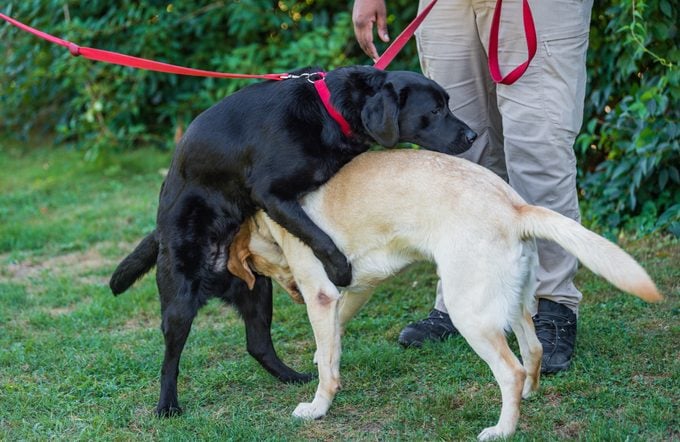
While humping is a natural behavior, you certainly don’t want your leg, or someone else’s, to become an unwilling participant. Plus, not all dogs are keen to be mounted and might growl or bite. Before you attempt to train your dog to stop excessive humping, it’s essential for a veterinarian to rule out medical causes.
“Stopping them from expressing themselves may cause you to miss clues as to how they are feeling or cause mental distress,” says Renee Rhoades, a multi-certified dog behaviorist and the founder of R+Dogs, a virtual dog behavior consultancy. The key to this type of dog training is to prevent the behavior and replace it with something more appropriate.
How to stop a dog from humping people
Have you noticed a correlation between your dog’s humping and new people stopping by your home? This could be a sign that your dog is either excited or stressed when meeting new people and humps to soothe. The first step to help your dog stop humping people would include managing your dog’s environment to prevent, or at least reduce the behavior.
Your first instinct may be to clap and yell, “Stop it!” That might work in the moment, but it’s not likely to work long term. “Rather than depending on something like verbal cues, harsh words or body blocking, it is better to manage the situation so the dog does not get to practice the behavior in the first place,” says Heidi Meinzer, a professional dog trainer.
Ensure your pup’s mental stimulation and exercise needs are met before guests arrive, which may help your dog feel more content and relaxed. You can keep your dog crated or on a leash when you have guests. If you use a leash, place a yummy treat on the floor when the guest approaches. The treat gives your dog nose work and helps decrease stress or excitement by redirecting your dog’s focus to the ground. But old habits die hard, so don’t be surprised if, even on the leash, your dog makes a beeline for guests. “If your dog does start to mount your guest, call their name to get their attention and reward them for coming away from the person,” says Rhoades.
Meanwhile, before the next set of guests shows up, start practicing a more appropriate behavior with people in the household and then move to people you know before new guests arrive. “I would work with the dog on leash and doing incompatible behaviors like ‘sit’ or ‘down’ with lots and lots of reinforcement before you try any scenarios working off leash,” says Meinzer.
How to stop a dog from humping other dogs
Just like with humans, the key is to manage your pup’s environment. When you catch your dog humping another dog, gently remove your dog from the other dog. “I like to do this by holding on to their harness at the back then gently lifting them and move them to the side. I will calmly talk to the dog and let them know I am going to move them off,” says Rhoades. As mortifying as it is, it is best to keep your emotions in check and not get angry or hastily yank your dog from the other dog.
If you assess that your dog is humping because they are nervous around other dogs, it’s probably not a good idea to take them to the dog park or other places where dogs are congregating. If you have no choice but to be around other dogs, you can keep your distance by keeping your pup on a leash. “Keeping your dog on a leash and away from the other dogs is a great way to prevent the behavior from happening in the first place so you don’t have to assess the mounting,” says Rhoades. That doesn’t mean your hope of doggy playdates is lost. “You may be able to work slowly up to play with an appropriate dog, but you need to be prepared to continually manage the situation so that your dog does not practice the behavior,” adds Meinzer. Start slowly with cues that will keep your dog calm and focused with other dogs present.
How to stop a dog from humping pillows
When your dog humps a stuffed animal or your favorite pillow from the sofa, it’s so bizarre and gross you have to wonder why do dogs hump inanimate objects—and is it normal? “It is absolutely fine if your dog mounts inanimate objects like toys, beds and pillows,” says Rhoades.
Still, you should be concerned if the humping is excessive or your dog seems stressed. “If mounting becomes a daily event and your vet has ruled out medical causes, there is a possibility that your dog is mounting items out of boredom or hyper-arousal. In these circumstances, it would be advisable to look at what your dog is doing during the day,” says Rhoades. Are they getting enough exercise and mental stimulation? Are they allowed to do doggy-specific things like sniffing on walks? “There could be an underlying concern that your dog is mounting because they do not feel enough fulfillment in their life.” You can also remove the items your dog regularly humps to help prevent the behavior. Then redirect their attention by playing a brain game or offering a treat puzzle.
“If you can’t figure out the missing piece yourself, a qualified behaviorist will be able to do that—and probably a lot faster,” says Rhoades.
About the experts
- Darris Cooper, CPDT-KA, FFCP, serves as national dog training manager at Petco. He holds certifications as a Fear-Free Animal Trainer, American Kennel Club Canine Good Citizen Evaluator and the Head of Diversity, Equity and Inclusion with the International Association of Animal Behavior Consultants (IAABC). He has trained animals at zoological facilities in Southern California, working with both domestic and exotic animals, and has his own “zoo” at home with three red-eared slider turtles—Leonardo, Michelangelo and Donatello—and two dogs, Zakai, a golden retriever, and Kalea, a German shepherd mix.
- Matthew McCarthy, DVM, has been practicing veterinary medicine for 25 years and founded Juniper Valley Animal Hospital, an animal practice in Queens, New York. Growing up, he spent summers tending to farm animals on his uncle’s farm in Kerry, Ireland. When he’s not busy in the animal hospital, you might find him watching his favorite animal movie, Best in Show, with his four cats, Floofy, Jeffy, Marble and Pumpkin, and his Weimaraner named Norbert.
- Heidi Meinzer, JD, CPDT-KSA, CNWI, is the interim chair for the Association of Professional Dog Trainers. In addition to being a certified professional dog trainer and certified nose work instructor, Heidi is an animal law attorney in Alexandria, Virginia. She resides with her favorite canine companions, Hannah, a Labrador retriever, and Arwen, a German shepherd.
- Renee Rhoades is an award-winning, multi-certified dog behaviorist with a master’s degree in animal welfare science and ethics. She is the founder of R+Dogs, a virtual dog behavior consultancy offering private coaching and online courses. She specializes in coaching dog guardians to help fearful and fired-up dogs overcome aggression, reactivity, anxiety and hyperactivity. She also co-hosts Doglogical, a podcast on dog behavior. Renee is a dog mom to Nero, a whippet/border collie, and Lycan, a German shepherd.



















